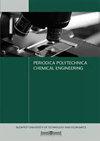Synthesis of PET-Magnesium Oxide-Chitosan Nanocomposite Membranes for the Dehydration of Natural Gas
IF 1.8
4区 工程技术
Q3 ENGINEERING, CHEMICAL
引用次数: 0
Abstract
Flat thin-film magnesium oxide-chitosan nanocomposite membranes were synthesized with polyethylene terephthalate (PET) and employed for natural gas dehydration. The water vapor permeation was most pronounced with a nanocomposite membrane doped with 0.9 g MgO nanoparticles (NP) as a result of a significant upsurge in the permeability of water vapor in the membrane (0.87). With the increase in MgO NP, large macro-voids are created, substratum pore size, and thickness together with the water vapor permeation were upsurged. The dehydration of natural gas performance of magnesium oxide-chitosan nanocomposite membranes synthesized with PET was enhanced with the increase in MgO NP embedded in the membrane. Though water vapor permeation was restricted by the polyester non-woven material used as a support for the nano composite membranes, as the three membranes did not reach the permeation coefficient of 1. However, the permeation coefficient increased with an increased MgO NP, with three mambrane samples (M1, M2 and M3) having permeation coefficient of 0.763, 0.77 and 0.87 respectively. The gas reduced with an increase MgO NP, with M1, M2 and M3 having 3.46×10−2, 3.17×10−2 and 3.88×10−3 kg/m3 respectively. From the adsorption study, the discrepancy observed between CH4 and vapor with isotherm models was ascribed to the different adsorption behavior of CH4 and vapor on the membrane-active area. The cost of making the membrane cannot be considered as a terminal criterion because most of the cost-effective option is not always the optimum one. The membranes confirmed their suitability for the dehydration of natural gas.天然气脱水用pet -氧化镁-壳聚糖纳米复合膜的合成
以聚对苯二甲酸乙二醇酯(PET)为原料合成了平面氧化镁-壳聚糖纳米复合膜,并将其用于天然气脱水。当纳米复合膜中掺杂0.9 g MgO纳米粒子(NP)时,其水蒸气渗透性显著提高(0.87)。随着MgO NP的增加,形成了较大的宏观孔隙,基质孔径、厚度和水蒸气渗透率均增大。PET合成的氧化镁-壳聚糖纳米复合膜的天然气脱水性能随着膜中MgO NP的增加而增强。虽然由于纳米复合膜的支撑材料为聚酯无纺布,限制了水蒸气的渗透,但三种膜的渗透系数均未达到1。但随着MgO NP的增加,渗透系数逐渐增大,3种膜样品(M1、M2和M3)的渗透系数分别为0.763、0.77和0.87。随着MgO NP的增加,气体减少,M1、M2和M3分别为3.46×10−2、3.17×10−2和3.88×10−3 kg/ M3。从吸附研究来看,等温模型观察到的CH4和水蒸气的差异归因于CH4和水蒸气在膜活性区域的不同吸附行为。制作膜的成本不能被认为是一个最终标准,因为大多数具有成本效益的选择并不总是最优的。这些膜证实了它们对天然气脱水的适用性。
本文章由计算机程序翻译,如有差异,请以英文原文为准。
求助全文
约1分钟内获得全文
求助全文
来源期刊

Periodica Polytechnica Chemical Engineering
ENGINEERING, CHEMICAL-
CiteScore
3.10
自引率
7.70%
发文量
44
审稿时长
>12 weeks
期刊介绍:
The main scope of the journal is to publish original research articles in the wide field of chemical engineering including environmental and bioengineering.
 求助内容:
求助内容: 应助结果提醒方式:
应助结果提醒方式:


